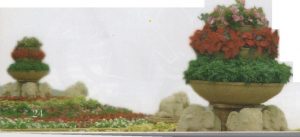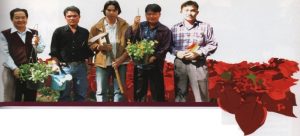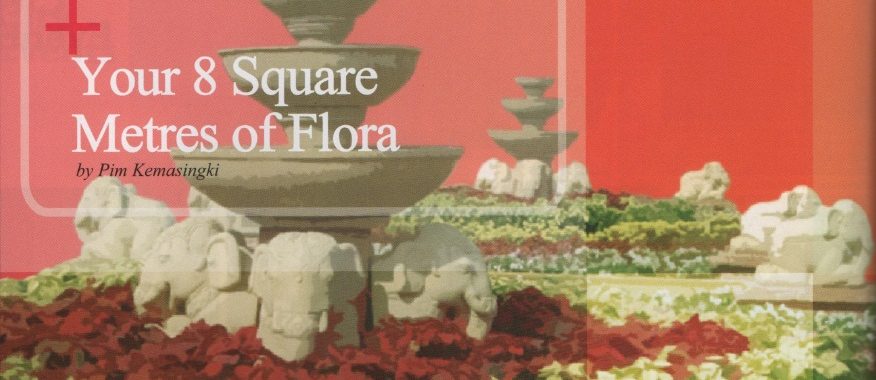Most of Chiang Mai’s growth over the past few years has involved such ersatz and spurious elements as pollution, construction, population and traffic. There is much to bemoan.
How many of you though, have noticed the delightful and flamboyant growth of Chiang Mai’s gardens and flowers? It’s hard not to. On every moat corner, along major roads and highways leading to and from the city, in our parks, along walls of temples and museums, a riot…no, revolution, of greens, reds, blues, purples – and every shade and hue in between – are planted, placed, maintained and replaced with efficiency and abundance.
Do little elves and gnomes come out at night to magically wave a wand-brush of colour over the city? One would think so from the speed and regularity with which our flowerscapes are transformed.
But no, the chief gnome of Chiang Mai city is not an oddly shaped humanoid with bright green fingers, but a pragmatic civil servant called Atichard Choowong, the Head of the Public Parks Section under the Chiang Mai Municipality’s Infrastructure Department, who works with his 70 merry men and women.
“It all began nearly three years ago,” Atichard started the interview like a fairy tale. “Chiang Mai is a special city and we had always been well favoured by tourists, but at that time there was much talk about the city’s over-development, its tired tourist industry and the need to talk with people in the government, private and academic sectors to think of Chiang Mai’s future. Lord Mayor Boonlert Buranupakorn therefore decided to start off a pilot project on 45 locales in Chiang Mai, hand picked for beautification. Because we were so new, we didn’t even touch the moat for nearly two years in fear of making too many mistakes!”

Atichard, a long-time civil servant with a degree in management, was offered the task of creating a plan to make Chiang Mai’s public spaces more attractive. The mayor’s office wanted to make Chiang Mai a more pleasant city to live in for residents as well as a city in which tourists would wish to linger, thus helping the overall economy. The first thing Atichard did was to hire key experts as well as begin consultation with the private sector and see what they could offer the municipality.
“Our department’s responsibilities are very large and are divided into three main tasks,” continued Atichard. “Our first responsibility is to decorate the city. This doesn’t just mean bedecking it with plants and flowers; we have to find art works such as sculptures and installations to add as highlights. We are also in charge of procuring more green spaces for the city and working closely with organisers of such events as songkran, loy kratong and the flower festival. The second area of responsibility is maintenance, especially that of public parks. The last three years have seen a massive leap in commitment to procure and maintain public spaces. I would also like to add that the accepted city standard for green spaces is four square metres per person; Chiang Mai currently offers each resident eight square metres of green which is very good news indeed and finally a budget has been allocated for this purpose. Lastly there is the nursery and breeding programme: we actually spend a lot of money breeding the one million plants used by our department in Chiang Mai city every year as well as giving many of these flowers and plants away for free to those who wish to decorate their houses or offices.”
With the success of the first year’s 45 locations – Nawarat Bridge, Mahidol airport road, Huay Kaew, etc. – the budget has steadily increased each year from a few million baht in 2002 to over 20 million marked for 2006. And it is hard to turn a corner in the city now without seeing a cluster of flowers nodding in the wind…or traffic fumes.
The project has its critics. Many conservationists have protested against the use of mainly European breeds of flowers such as pansies, petunia, verbena, fox gloves, marigolds and fox fires. There are also those who frown at the seeming waste of interchanging plants, -claiming that cities such as Singapore use their indigenous perennial tropical plants to blanket their modernity with green. The municipality sees things differently and puts it down to practicalities. Thai flora are not mass-produced, aren’t easy to grow in a nursery, cost more and are not well researched nor bred for varying conditions. “I simply don’t have time to wait for tropical flora,” explains Methee Jina, Atichard’s right hand expert and head of city public space and decorations. “I am well aware that Chiang Mai is cultural town and that we have various groups of watchdogs who keep a very close eye on what we do,” said Methee, a native graduate of agricultural landscaping who went on to gain his masters in management. “We need to keep up with the times and the breeds. New breeds are simply better: they last longer, are more colourful, and are more suited to the environment. We use indigenous green plants for permanency and, let’s say, garnish with seasonal highlights of colour,” he explained pointing to 2006’s plans which showed quarterly revamps of our city’s floral decor. “As you can see we have to plan colour schemes according to festivities or seasons at least a year in advance for breeding purposes. This isn’t just for tourists, but we want someone who drives up and down Huay Kaew Road every day of their lives to have new vistas to look at from time to time.”

Atichard (secondfrom right) and his team at Kanok Maledphan’s (left) Galae Restaurant
Both men own up to numerous mistakes and ask the public to bear with them during this learning period. “When we planted pretty flowers along Huay Kaew Road, we didn’t consider the pedestrian traffic which crosses over constantly killing the plants. We didn’t get upset with the people, because it is their city, we just made a few adjustments and found a more suitable solution,” continued Methee amiably. Look at the Tha Pae/Kotchasam roads intersection where we changed the traffic flow by placing ugly plastic barriers in the middle of the road to discourage drivers from Tha Pae from attempting to cross the moat too soon. We received a barrage of complaints from residents, but I would just like to explain that motorists not used to the new traffic flow kept crashing and bumping into the barrier. When they became more accustomed we put potted plants there until eventually a more permanent structure will be built by the time you read this. This has been planned from the start. Sometimes what we do may not make sense, but there is a purpose and a process which we must go through. I may as well warn your readers that the next few months we will be making changes to the moat systems, so once again, please be patient.
The Ping River is also another major area to be revamped throughout 2006.”
Apichard and his team began tackling the moat as part of Thaksin’s Clean and Green project in 2005. “One thing which was most important to US was that none of our plants or decorations caused any harm to people or animals,” he added. “We do not use pesticides: if plants die, they die. We use fertilizer, but are still learning and if that means losing plants in the process then so be it. For instance when we planned for 2005, we based our planning on 2004’s weather pattern. As we all know, 2005 did not follow any normal weather pattern and we lost many plants. We must be aware of everything from falling leaves and branches which necessitate maintenance and compare them to those which wither at the stems requiring frequent change.”
Word from on high is favourable. Apichard and his team have received accolades for their efforts and dedication and Chiang Mai is now seen throughout Thailand as a city of example, with Apichard’s peers in Pattaya, Nakorn Ratchasima and even Koh Pang Ngan coming to Chiang Mai to study the project as well as purchase plants from the many happy suppliers. Controlling a budget of tens of millions (10 million for festivities – 2 million for the Flower Festival this February alone – annual wage bill of 2-3 million as well as a regular city decor budget of 10 million) Apichard is looking forward to a bright future for himself as well as for Chiang Mai.
“It’s not just about flowers,” he explains, “It’s about management. We are learning to accept help from experts such as Kanok Maledphan, the owner of N.A.T Suankaset (and the very floral Galae restaurant) who supplies us with flowers worth nearly one million baht per year. Not only that, his know-how of latest breeds and trends has helped US to learn and improve dramatically. We are also learning to outsource maintenance to the private sector, as well as learning to work closer with the public to accept their participation and advice.”
So next time you drive around Sri Phum moat corner, along Huay Kaew Road or into the city from Hang Dong, take a moment to think about Apichard, Methee and their gang of gardeners and administrators. Your eight square metres of the city appear to be in good hands.
